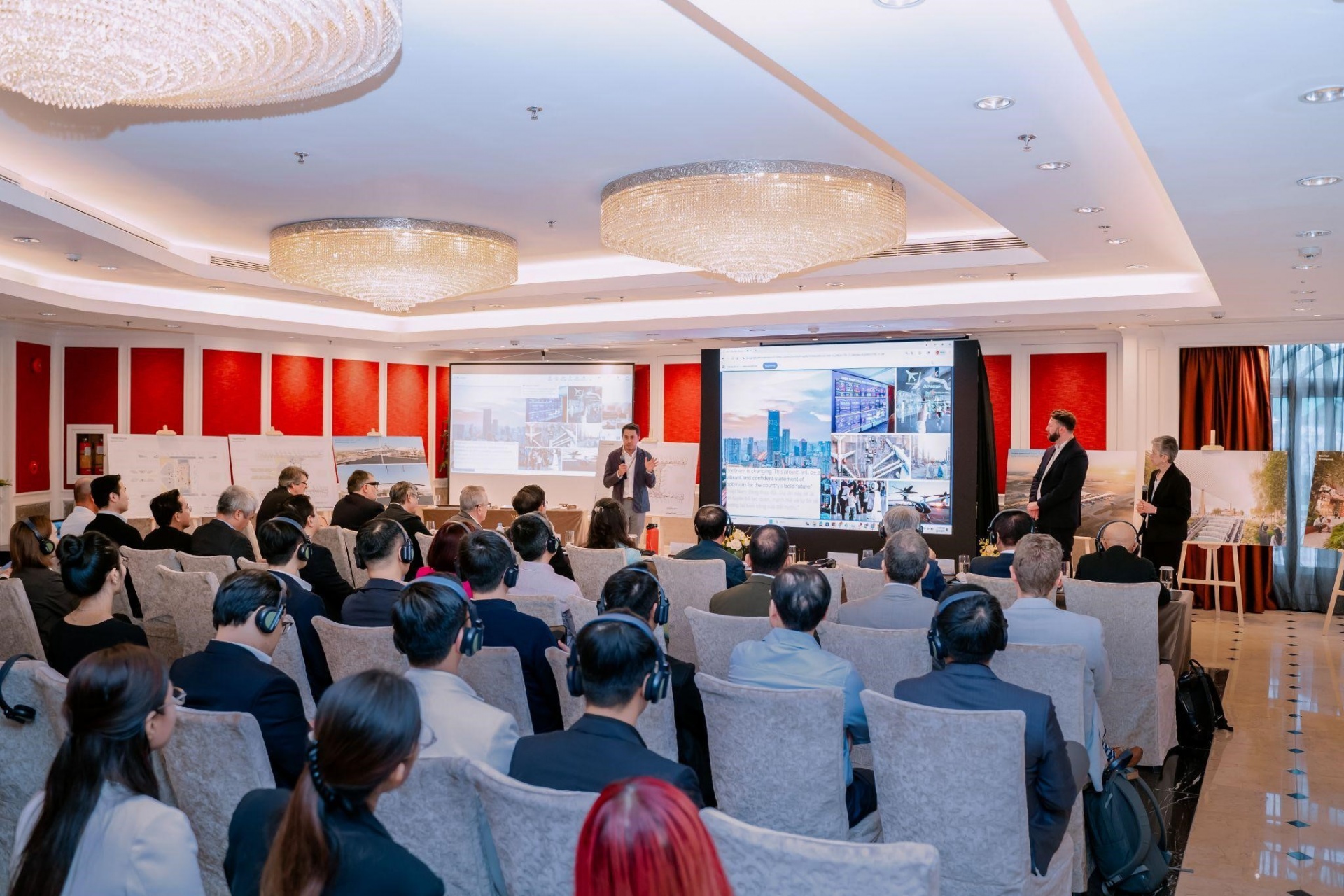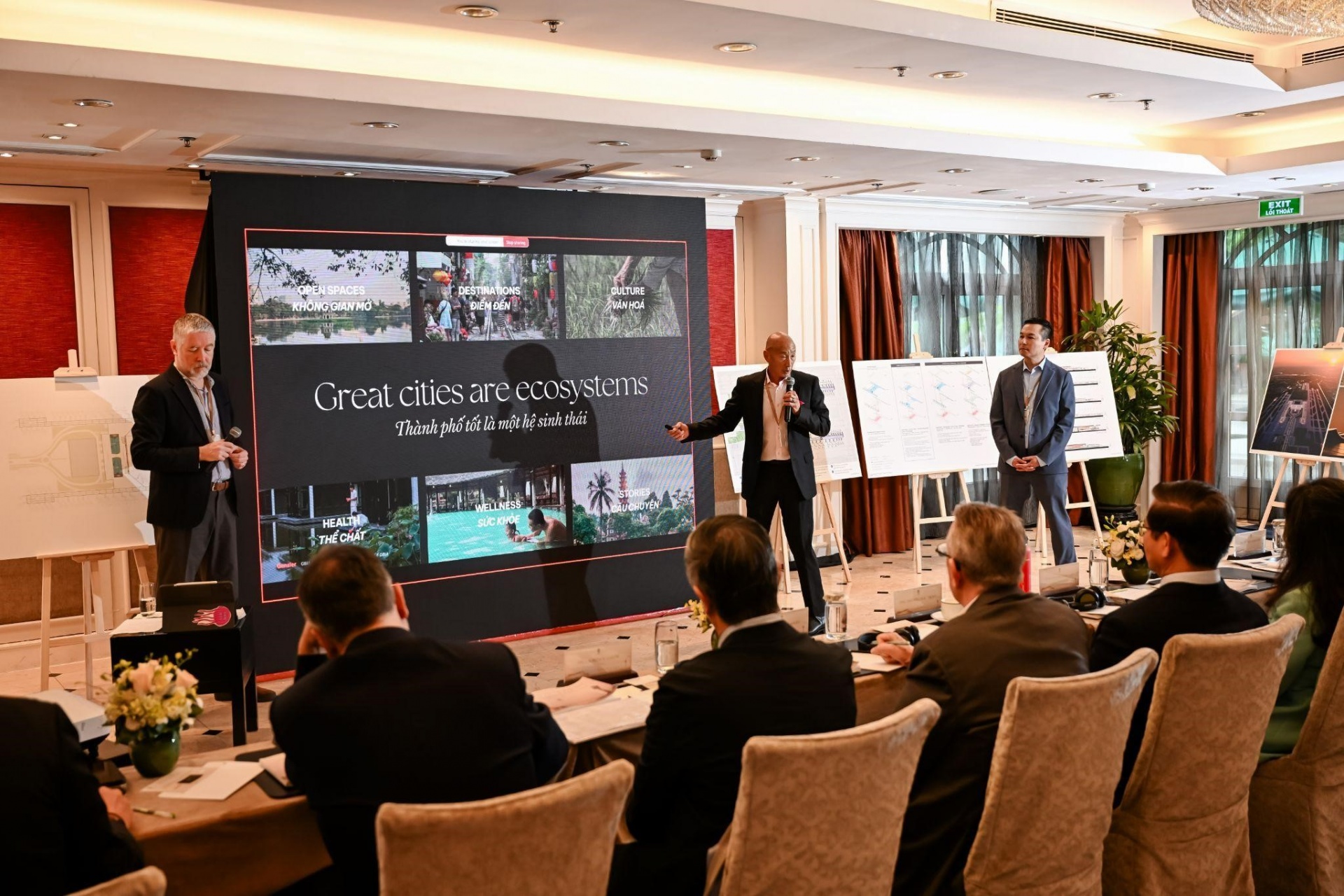Organised by Masterise Group, the Architectural Design Competition for the Gia Binh International Airport Passenger Terminal brings together Gensler (US), Skidmore, Owings & Merrill (US), and Nikken Sekkei (Japan) to identify the optimal design for Vietnam’s new landmark. The competition represents a key step in developing strategic national infrastructure during a new era of Vietnam’s growth.
On November 8, the presentation round took place at Sofitel Legend Metropole Hanoi, featuring the three architectural giants. These firms are behind some of the world’s leading Skytrax 5-star airports – Incheon (South Korea), Haneda (Japan), and Changi (Singapore) – and bring proven expertise in creating passenger terminals that are functional, sustainable, and infused with local identity.
 |
The competition was structured as an international design process to select the most suitable architectural solution for the Gia Binh International Airport Passenger Terminal. It followed a rigorous professional protocol: live presentations, independent evaluation, secret voting, transparent result announcement, and full compliance with Vietnamese legal regulations as well as international standards in architecture, planning, and construction.
The final presentation round was assessed by an international jury of leading experts in architecture, urban planning, aviation, and large-scale infrastructure development. The panel included Prof. Richard De Neufville of MIT (US); Moshe Safdie, Israeli–Canadian–American architect and urban planner of Safdie Architects; Cristiano Ceccato de Sabata, director at Zaha Hadid Architects; Laurence Liauw, principal director of SPADA (Hong Kong) and adjunct Assoc. Prof. at the University of Hong Kong’s Faculty of Architecture, and Trevor Carnahoff, programme director and Regional Market Solutions lead for Asia Aviation at Jacobs.
Joining the international experts were representatives from the Ministry of Public Security, Ministry of Construction, Bac Ninh Department of Construction, and senior leaders of Masterise Group, ensuring the competition adhered to legal requirements, professional standards, and international best practices.
In a focused and highly professional atmosphere, all three participating firms presented distinct concepts, demonstrating careful research into local context and the long-term development trajectory of Vietnam’s aviation sector.
Pursuing a next-generation 'smart - green - sustainable' airport model that supports socioeconomic development, each proposal rooted its architectural concept in Vietnamese culture and landscape, placing people and passenger experience at the centre. Design considerations balanced feasibility, long-term sustainability, operational efficiency, aesthetics, and the ability to express Vietnamese identity through contemporary airport architecture.
Several notable sustainability ideas were highly regarded, such as rainwater harvesting and reuse systems, optimised daylight through skylights, natural nighttime ventilation, low-carbon materials such as timber and terracotta, and integrated rooftop solar power systems.
These approaches demonstrate the dedication and creative capacity of the three global teams in envisioning an integrated, future-ready airport – where architecture, engineering, and passenger experience converge within a unified vision of sustainable development.
 |
"Our approach to designing the new terminal for Gia Binh was to create a concept inspired by Vietnam’s landscapes, resonating with people across the country," said Jordan Pierce, senior associate principal at Skidmore, Owings & Merrill. "We envision an airport that we call the ‘Terminal of the Water Gardens,’ where each stage of the passenger journey is defined by a unique landscape experience centred around water."
The jury panel assessed all submissions against 10 comprehensive criteria, including technical feasibility, sustainability, creativity, cultural coherence, functionality, and aesthetics. Designs were also required to meet international standards for modern airport planning and operations. The selection process was conducted objectively, with independent evaluations and direct professional dialogue, ensuring transparency and high-quality decisions.
 |
"I believe this is an ideal time for Hanoi to develop a new airport," said Liauw. "The existing airport has long served its purpose and reached full capacity, so the new facility is not just about expanding capacity but also creating opportunities to grow the aviation sector. With the economy and population growing rapidly, and Hanoi increasingly recognised as a global tourist destination, the new airport will be a valuable addition to the country’s expanding tourism and aviation industry."
As the future northern gateway airport and a regional hub for passengers, cargo, and MRO services, the Gia Binh International Airport is poised to drive growth for Hanoi and the northern key economic regions, strengthening Vietnam’s competitiveness in logistics, high-tech industry, and large-scale commercial services.
Designed to meet ICAO 4F technical standards and Skytrax 5-Star service benchmarks, the airport is a national strategic project with economic, security, defence, and diplomatic significance.
With a projected capacity of 30 million passengers and 1.6 million tonnes of cargo per year by 2030, expanding to 50 million passengers and 2.5 million tonnes of cargo by 2050, the airport aims to stand alongside leading regional hubs such as Changi (Singapore), Incheon (South Korea), and Suvarnabhumi (Thailand).
Gia Binh International Airport is expected to become Vietnam’s new hub of international connectivity – embodying advanced operational standards, an integrated service ecosystem, and strong global linkages.
 |
Beyond technical and operational targets, the airport aspires to be a symbol of sustainable, smart, green development. From spatial planning and materials selection to operational technologies, the undertaking prioritises sustainability, energy efficiency, environmental protection, and user experience.
The Architectural Design Competition for the Gia Binh International Airport Passenger Terminal – international in scale and executed with rigorous professionalism – reflects the strategic vision of the scheme and Masterise Group’s strong commitment to mobilising global expertise and innovation for Vietnam’s next generation of national infrastructure.
| International experts in the Jury Panel
|

















































